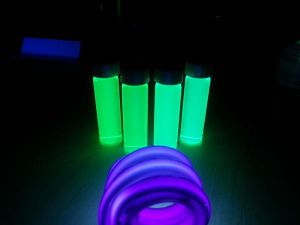Pyranine
 Pyranine fluoresces green in neutral conditions and blue in acidic conditions (left to right).
| |
| Names | |
|---|---|
| IUPAC name
Trisodium 8-hydroxypyrene-1,3,6-trisulfonate
| |
| Other names
8-Hydroxypyrene-1,3,6-trisulfonic acid, Na3 salt
HPTS Solvent Green 7 Sulfonated hydroxy pyrene trisodium salt | |
| Properties | |
| C16H7Na3O10S3 | |
| Molar mass | 524.37 |
| Appearance | Yellow-green crystalline powder |
| Melting point | 300 °C (572 °F; 573 K) (decomposition) |
| Boiling point | Decomposes |
| Soluble | |
| Hazards | |
| Safety data sheet | Sigma-Aldrich |
| Lethal dose or concentration (LD, LC): | |
| LD50 (Median dose)
|
1,060 mg/kg (mouse, IV) |
| Except where otherwise noted, data are given for materials in their standard state (at 25 °C [77 °F], 100 kPa). | |
| Infobox references | |
Pyranine is a yellow arylsulfonate dye, commonly found in highlighters, that exhibits strong fluorescence.
Contents
Properties
Chemical
The fluorescence of depends on the pH of the solution, which makes it a fluorescent pH indicator. At low pH levels, the color of its fluorescence changes from green to blue. It also acts as a regular pH indicator, and turns from yellow to colorless at the same low pH levels.
Physical
Pyranine is highly soluble in water.
Acquisition
Relatively pure pyranine can be found in highlighters and used as a pH indicator.
Preparation
Pyranine can be prepared by refluxing an aqueous solution of sodium hydroxide and pyrenetetrasulfonic acid. Pyranine crystallizes as yellow needles when adding an aqueous solution of sodium chloride.[1]
Projects
- "Radioactive" color-changing baking soda volcano
- Lava lamp
Handling
Safety
Pyranine has low toxicity.
Storage
It should be stored in closed containers.
Disposal
Pyranine can be safely poured down the drain.